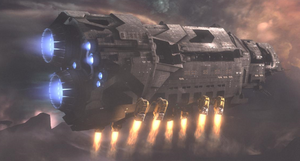R7 thrust coupling: Difference between revisions
From Halopedia, the Halo wiki
No edit summary |
mNo edit summary |
||
| Line 3: | Line 3: | ||
'''R-7 thrust couplings''' are a form of [[United Nations Space Command|UNSC]] propulsion system used to lift spacecraft out of atmosphere and into orbit. Attached to [[hardpoint]]s on the underside of the vessel, they are commonly used by smaller craft such as [[UNSC corvette|corvettes]] or [[UNSC frigate|frigates]] when entering and leaving docking facilities on a planetary surface.<ref name="drop">[http://halo.xbox.com/en-us/news/headline/office-of-naval-intelligencesection-3-data-drop-six-/290609 '''Halo Waypoint''': ''Data Drop 6'']</ref> When taking off, the booster packages are typically discarded once the craft has achieved enough lift to leave the atmosphere on its own.<ref name="POA">'''[[Halo: Reach]]''', campaign level, ''[[The Pillar of Autumn (Halo: Reach level)|The Pillar of Autumn]]''</ref> | '''R-7 thrust couplings''' are a form of [[United Nations Space Command|UNSC]] propulsion system used to lift spacecraft out of atmosphere and into orbit. Attached to [[hardpoint]]s on the underside of the vessel, they are commonly used by smaller craft such as [[UNSC corvette|corvettes]] or [[UNSC frigate|frigates]] when entering and leaving docking facilities on a planetary surface.<ref name="drop">[http://halo.xbox.com/en-us/news/headline/office-of-naval-intelligencesection-3-data-drop-six-/290609 '''Halo Waypoint''': ''Data Drop 6'']</ref> When taking off, the booster packages are typically discarded once the craft has achieved enough lift to leave the atmosphere on its own.<ref name="POA">'''[[Halo: Reach]]''', campaign level, ''[[The Pillar of Autumn (Halo: Reach level)|The Pillar of Autumn]]''</ref> | ||
Non-atmosphere spacecraft such as {{Class|Halcyon|light cruiser}}s are also capable of limited atmospheric operation if enough thrust couplings are affixed to their hull, although their maneuverability is extremely limited; [[Lieutenant Commander]] [[Gail Purdy]] noted that "it'd be like flying a brick with bottle rockets."<ref name="drop"/> Regardless, during the [[Fall of Reach]], the {{UNSCShip|Pillar of Autumn}} successfully used | Non-atmosphere spacecraft such as {{Class|Halcyon|light cruiser}}s are also capable of limited atmospheric operation if enough thrust couplings are affixed to their hull, although their maneuverability is extremely limited; [[Lieutenant Commander]] [[Gail Purdy]] noted that "it'd be like flying a brick with bottle rockets."<ref name="drop"/> Regardless, during the [[Fall of Reach]], the {{UNSCShip|Pillar of Autumn}} successfully used four pairs of these to land onto and lift off a drydock at the [[Aszod ship breaking yards]] and escape the planet.<ref name="POA"/> | ||
==List of appearances== | ==List of appearances== | ||
Revision as of 14:55, July 13, 2013

R-7 thrust couplings are a form of UNSC propulsion system used to lift spacecraft out of atmosphere and into orbit. Attached to hardpoints on the underside of the vessel, they are commonly used by smaller craft such as corvettes or frigates when entering and leaving docking facilities on a planetary surface.[1] When taking off, the booster packages are typically discarded once the craft has achieved enough lift to leave the atmosphere on its own.[2]
Non-atmosphere spacecraft such as Halcyon-class light cruisers are also capable of limited atmospheric operation if enough thrust couplings are affixed to their hull, although their maneuverability is extremely limited; Lieutenant Commander Gail Purdy noted that "it'd be like flying a brick with bottle rockets."[1] Regardless, during the Fall of Reach, the UNSC Pillar of Autumn successfully used four pairs of these to land onto and lift off a drydock at the Aszod ship breaking yards and escape the planet.[2]
List of appearances
- Halo: Reach (First appearance)
Sources
- ^ a b Halo Waypoint: Data Drop 6
- ^ a b Halo: Reach, campaign level, The Pillar of Autumn